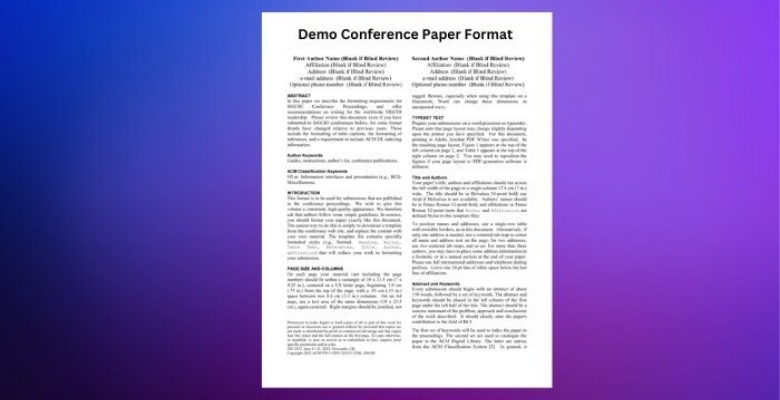A conference paper is a written document that researchers prepare to share their studies at academic events. It often follows specific structures that make it easy to read, organized, and professional. Many people preparing one wonder about the correct conference paper format.
Format a conference paper by following the organizer’s template exactly. Use sections like title, abstract, introduction, methods, results, discussion, and references. Common formats include IEEE, ACM, Springer LNCS, and Elsevier. Choose the correct template, maintain a clean structure, and check for word/page limits to improve clarity and acceptance chances.
Do you want to know why following these formatting rules really matters? Keep reading this article, because here you will find every important detail explained clearly, along with step-by-step guidance that will help you understand all parts of the topic.
Conference Paper Format
Writing a conference paper often requires following a specific format, and each publisher or organizer has their own style. These formats are designed to keep papers organized and easy to read. Let’s look at some of the most common academic conference paper formats used today.

IEEE Format
The IEEE format is popular in engineering, computer science, and electronics conferences. It uses a two-column layout, which saves space and looks neat. Papers usually have a page limit of 6 to 10 pages. Templates are available for both Word and LaTeX.
Download the PDF sample
ACM Format
In computer science and IT conferences, the ACM format is frequently utilized. It comes in two versions: single-column for manuscript submission and two-column for final versions. Ready-made templates are available in Word and LaTeX, making it easier for authors to prepare papers.
Download the PDF sample
Springer LNCS
Technical and computer science conferences frequently use Springer’s Lecture Notes in Computer Science (LNCS) format. It usually has a single-column style with strict rules for margins, fonts, and spacing. Authors must follow these details carefully, as even small mistakes may cause rejection.
Download the PDF sample
Elsevier Format
A structured format offered by Elsevier is utilized in numerous conferences related to science, medicine, and engineering. Most Elsevier papers follow a single-column design with clear sections like introduction, methods, results, and conclusion. Their templates in Word and LaTeX make the writing process smoother for researchers.
Download the PDF sample
Taylor & Francis
In the humanities, management, and social sciences, Taylor & Francis conference papers are typical. The format usually has a single-column layout, making it easier to focus on reading. Word templates are provided, and they encourage a clear conference paper structure with well-defined sections. This format is often recommended for events like the International Arts, Education, and Humanities Conference, where clarity and readability are highly valued.
Download the PDF sample
Wiley Format
The majority of conferences in the applied sciences, health, and life sciences use Wiley’s format. These papers are generally written in a single-column style with clear section headings. The design helps readers follow the content easily, especially when technical details or health-related data are included.
Download the PDF sample
Different conferences have different rules for paper format. Choosing the right one and following it correctly makes your paper look professional and increases the chances of acceptance. Always check the official guidelines before you begin writing.
How to Format a Conference Paper?
Writing a conference paper requires following a set structure for clarity. The format helps present information in a way that looks professional. Each section has its own purpose, making the paper easy to understand. Let’s look at the common parts step by step.
Title and Author Information
The paper begins with a bold title placed clearly at the top. Underneath, the names of authors are shown with affiliations and institutions. Contact emails are added to ensure readers can reach authors easily. This section introduces both the research and the responsible contributors.
Abstract and Keywords
A brief summary highlights the research aim, process, and major results. The abstract is usually short and clear, often less than 250 words. After the abstract, a list of three to five keywords is added. These keywords help readers and indexing systems find the paper.
Introduction
This part gives background and explains the importance of the topic. It shows what problem exists and why the research is necessary. Authors describe the purpose and contribution their study is offering here. The introduction ends by outlining what the paper will cover.
Related Work or Literature Review
Earlier studies and important findings from other researchers are described in this section. The goal is to show where the current study fits in. It highlights past contributions while pointing out remaining gaps in knowledge. References are included to strengthen the review and credibility.
Method or Approach
Research design and steps are explained in detail for full understanding. Authors describe tools, data sources, or experiments that were applied carefully. The section ensures that another researcher could repeat the study if needed. Each procedure is clearly stated to make the process transparent.
Results
Findings are shared here, often supported by visuals such as charts or tables. The text should describe key results without offering too much interpretation. Information is arranged neatly to keep it easy for readers. Data presentation is central here to demonstrate research outcomes effectively.
Discussion
Interpretation of results is written in this section with clear reasoning. Comparisons are made between this study and earlier published research when needed. The meaning of the results is explained along with their possible importance. Authors may also include study limitations for transparency and fairness.
Conclusion and Future Work
The paper ends by summarizing its most important discoveries and findings. Authors repeat the central message without copying earlier content in detail. Some conferences encourage researchers to suggest possible future improvements or directions. This closing section leaves readers with final thoughts and next steps.
Acknowledgments
Thanks are given to people or organizations that helped complete the work. Funding agencies, universities, or supporting institutions are usually named here briefly. It can also include recognition of technical assistance or guidance offered. The section remains polite, professional, and generally very short overall.
References
Sources used and cited throughout the paper are collected in this section. Each entry should be complete with details like author, year, and title. Consistency is required according to the chosen conference style guide. Correct referencing shows respect for other scholars and builds credibility.
Appendix, Optional
Supporting material not essential for the main text appears in the appendix. It can include long tables, additional figures, or full mathematical proofs. Extra content provides depth but is not required for every reader. Including this section depends on specific rules set by conferences.
When you format your paper correctly, it’s not just about meeting conference submission rules. Good formatting also improves readability and flow. This becomes very helpful in interactive conference presentations, where your audience can follow along easily and focus on the main ideas instead of struggling with an unclear structure.
Why Conference Paper Format Rules Matter?
Conference paper format rules matter because they create a common structure that everyone follows. When all papers look the same, it is easier for reviewers and readers to focus on the content instead of struggling with the layout. This saves time and avoids confusion during evaluation.
Another reason is that formats maintain professionalism and quality across the conference. Each section, like abstract, introduction, or results, has a fixed place, making the paper organized. Standardized referencing also ensures that sources are properly credited, building trust in the research.
Finally, following format rules increases the chances of acceptance. Many conferences reject papers that do not meet the required style, even if the research is strong. By respecting guidelines, authors show attention to detail and seriousness about presenting their work.
What Are the Best Tools to Draft a Conference Paper?
When you use the right tools, you are able to stay organized, write clearly, manage references, and format your work. You can save time and make your paper stand out with the right tools, whether you’re writing your first paper or improving your writing process. Let’s look at some of the tools you can use now to draft a strong conference paper.
| Purpose | Recommended Tool(s) |
| Easy LaTeX writing | Overleaf, LyX |
| Team writing online | Authorea, Google Docs |
| Clear writing help | Grammarly, Writefull, Ref-n-Write |
| Manage sources | Zotero, Citavi |
| Format conversion | Pandoc |
Writing & Drafting Tools
- LaTeX / Overleaf
- LaTeX is widely used for research papers. It handles structure, citations, and formatting neatly.
- Overleaf is an online version of LaTeX. You can collaborate with others in real time, and it doesn’t need installation.
- LyX: A simpler version of LaTeX with menus and a user-friendly design. It lets you focus on writing without learning complex coding.
- Authorea: An online writing tool designed for researchers. It supports collaboration, citation management, and formatting based on conference requirements.
- Google Docs: Easy to use, works anywhere online, and supports team writing. It also has add-ons for citations.
Writing Helpers
- Grammarly: Helps catch grammar and spelling mistakes and improves clarity. Premium versions also check for plagiarism.
- Ref-n-Write: Provides sentence templates and phrase suggestions for academic writing. Great for improving flow and style.
- Writefull: Works with Word and Overleaf. It checks grammar, suggests better phrasing, and helps polish your writing.
Managing Research & References
- Zotero: A free reference manager to collect, organize, and cite sources. It integrates well with Word and Google Docs.
- Citavi: A powerful tool for reference management and idea organization. It also helps with outlining and planning tasks.
Format Conversion Tool
Pandoc: Converts documents between formats like Word, PDF, and Markdown. It also manages citations during conversion.
Basic Formatting Rules You Must Follow
Writing a conference paper needs following some important formatting rules carefully. These rules make sure all papers look neat and professional always. They also help readers understand the content without facing any problems. Let us look at some basic formatting rules step by step.
Paper Size, Margins, and Columns
Most conferences ask papers to be written using either A4 or letter size. Margins of one inch on every side are usually required. Many technical conferences use two columns, while some prefer a single-column layout. Following this standard keeps all papers consistent and reader-friendly.
Font Style and Size
Times New Roman is commonly chosen for writing conference papers everywhere. The main text is often kept at ten or eleven points. Larger and bold font sizes are normally used for headings only. Consistency in font use makes the paper look clean and professional.
Line Spacing and Paragraph Style
Papers are mostly written in single spacing to save page length. Sometimes spacing of 1.15 is also permitted by some conferences. Paragraphs usually begin without indentation, and a small gap is left. Proper spacing ensures the text looks easy to read and clear.
Section Headings and Numbering
Clear section headings guide the reader through the paper very effectively. Most conferences want sections numbered as 1, 1.1, or 2.2. Headings are often bold and sometimes written in uppercase letters. Numbering rules make the structure simple, organized, and easier to understand.
Figures, Tables, and Captions
Pictures, charts, or tables should appear near where they are discussed. Captions are placed under figures or above tables with clear explanations. Each figure or table should be numbered correctly and cited in text. These rules help readers understand visuals alongside the written content.
Equations and Symbols
Mathematical equations are centered and usually numbered along the right margin. Symbols must be consistent, clear, and explained properly if they are uncommon. Correct formatting prevents confusion and makes equations easier to follow. This way, readers can understand calculations without misreading or guessing.
In-text Citations and Reference List
Every idea taken from another source must be cited properly. Different conferences use different styles, like numbered brackets or author names. At the end, a full list of references is included. An accurate citation helps respect other researchers and also supports your work.
Page Limit and File Size
Conferences usually restrict the length of papers to six to ten pages. Longer papers may require an extra fee or could be rejected. File size limits also exist, especially for online PDF submissions. Keeping within these requirements increases the chances of paper acceptance.
Common Mistakes in Formatting Conference Papers and Easy Fixes
When preparing a conference paper, small formatting mistakes can reduce its quality and impact. Many writers struggle with spacing, fonts, references, or alignment. These errors may seem minor, but they affect the overall presentation. Let’s look at common mistakes and their simple fixes.
Wrong Font Choice
Using the wrong font makes a paper look unprofessional and sometimes harder to read. Most conferences ask for specific fonts like Times New Roman or Arial. Always follow the rules in the conference guidelines to avoid rejection or extra corrections later.
Incorrect Spacing
Spacing problems are common in papers. Writers sometimes use too much or too little line spacing, making the text crowded or stretched. Check if the requirement is single, 1.5, or double spacing, and apply it consistently throughout the paper.
Poor Reference Style
References are very important, but many writers forget to format them correctly. Each conference usually has a style, such as APA, MLA, or IEEE. Leaving these mistakes unchecked can lower the impact of your conference paper, but fixing them is often simple. Always double-check the reference list before submission.
Weak Section Alignment
If titles, headings, or paragraphs are not aligned properly, the paper looks messy. Some parts may appear too far left, right, or centered incorrectly. Use the alignment tools in your writing software to keep everything neat and professional throughout.
Unclear Figures and Tables
Figures and tables often create trouble. Sometimes they are blurry, oversized, or missing captions. Readers may struggle to understand them without clear labeling. Always use high-quality images, proper sizing, and clear captions that explain what the figure or table shows.
Easy Fixes for Formatting
- Use the recommended font, like Times New Roman or Arial.
- Check line spacing (single, 1.5, or double) and apply consistently.
- Follow the exact reference style requested (APA, MLA, or IEEE).
- Align headings, paragraphs, and sections neatly.
- Use high-resolution images for figures and tables.
- Add captions for every figure and table.
- Check margins and page size as per the guidelines.
- Proofread carefully for any overlooked formatting issues.
Formatting mistakes are easy to make but also easy to fix with attention and care. By following the guidelines and checking details, your paper will look professional and meet conference standards. Small corrections can make a big difference.
What Happens if the Conference Paper Margins or Fonts Are Wrong?
Formatting rules may look like small details, but they play a big role in how a conference paper is judged. Every organizer sets strict guidelines to keep papers consistent. Understanding what could happen if rules are ignored is important.
- Rejection Risk: Review committees often reject papers with wrong margins or fonts, even when the research is excellent, because formatting rules are strictly followed.
- Unprofessional Look: Incorrect formatting makes the paper appear messy and unpolished, which can leave a negative impression on both reviewers and conference readers.
- Review Problems: Difficult margins or unclear fonts make reviewing harder, slowing down the process and reducing the chances of receiving detailed and fair feedback.
- Printing Issues: Proceedings or journals may face printing errors if margins or fonts are not correct, causing layout problems and poor readability overall.
- Technical Checks: Many conferences use automated tools to check format compliance, and papers with wrong margins or fonts often fail these technical checks.
- Time Wasted: Authors may have to redo formatting and resubmit the paper, wasting valuable time and possibly missing important submission deadlines altogether.
- Lower Quality Perception: Readers often think papers with wrong fonts or margins lack care and effort, reducing the seriousness of the presented research work.
- Acceptance Delay: Extra corrections requested by organizers can delay acceptance and scheduling, which might reduce the chances of being included in the main sessions.
Even small formatting mistakes can cause major issues during submission. Reviewers value consistency because it saves time and ensures fairness. Following the given guidelines carefully shows professionalism and increases the chances of the paper being accepted smoothly.
How Do You Check Your Conference Paper Format Before Submission?
Before sending a conference paper, checking the format is just as important as checking the content. Small mistakes in fonts, spacing, or references can reduce the quality. A final check helps ensure the paper looks professional and follows the rules. Here’s what you should check:
- Compare with the official template.
- Confirm font style and size.
- Check spacing across the paper.
- Align headings and paragraphs neatly.
- Use the correct citation style.
- Verify page margins and numbering.
- Ensure tables and figures are clear.
- Proofread for formatting consistency.
Read the Guidelines Carefully
Always start by reading the conference’s official guidelines. Check details like font style, font size, margins, spacing, and reference style. Conferences often provide templates. Comparing your paper with the template is the easiest way to spot mistakes.
Check Fonts and Spacing
Make sure you are using the exact font and size mentioned, usually Times New Roman or Arial in size 12. Also, confirm the spacing, whether it is single, 1.5, or double. Consistent spacing makes your paper clean and easy to read.
Review Headings and Sections
Look at the alignment of your titles, subheadings, and paragraphs. Headings should be uniform, not mixed styles. Paragraphs should be aligned neatly without random indents or extra spaces. A well-structured paper looks organized and easy to follow.
Inspect References and Citations
Check that your references match the required style, such as APA, MLA, or IEEE. Make sure in-text citations and the reference list are consistent. Wrongly formatted references can lead to rejection, so take time to proofread them carefully.
Verify Figures and Tables
Ensure that all figures and tables are clear, properly sized, and labeled with captions. They should not look blurry or stretched. Place them where they are easy to understand, and check if the guidelines mention specific placement rules.
FAQs About Conference Paper Format
Conference paper formatting often raises many small but important questions that are not always covered in the main guidelines. Authors sometimes wonder about file types, figures, or even how to handle mistakes after submission. Here are some useful FAQs to help clear doubts.
What File Format Should I Submit My Paper In?
Most conferences prefer papers submitted as PDF files because they are secure and keep formatting unchanged. A PDF also ensures that fonts, margins, and images appear exactly as intended across devices. Some conferences may also ask for Word or LaTeX files in addition to PDF. Always check the official instructions before uploading your paper.
Can I Use Color in My Conference Paper?
Yes, many conferences allow the use of color in figures, graphs, or tables to make data easier to understand. However, it is smart to make sure your work is also readable in black and white, because some printed proceedings may not use color. Use patterns, labels, and captions to explain visuals clearly. This way, your paper stays understandable in any format.
How Should I Handle Footnotes in My Paper?
Footnotes are usually allowed but should be used sparingly. They are best for short explanations or extra information that does not fit well in the main text. Too many footnotes can make the paper look cluttered and distract readers. Check if the conference style guide has specific rules about footnotes before using them.
Do I Need To Add Page Numbers To My Paper?
In most cases, you should not add your own page numbers because conference templates usually control that. If you try to add them yourself, it can break the template and cause layout problems. Instead, stick to the provided format to avoid errors. Reviewers will always see the correct numbering in the compiled version.
Can I Include Appendices in My Paper?
Yes, some conferences allow appendices for extra data, proofs, or large tables. However, you should not put important results there because reviewers may skip them. The appendix should only contain supportive information that adds clarity but is not essential. Always confirm if the conference allows appendices before adding one.
Should I Include Author Biographies in My Paper?
Some conferences require short author biographies at the end of the paper, while others do not. If it is required, each biography should be brief, usually two to three sentences long. It often includes your current position, institution, and research interests. Always follow the instructions to avoid leaving out necessary information.
How Do I Format Mathematical Equations?
Equations should be centered on the page and numbered clearly, usually along the right margin. Each symbol should be explained if it is not widely known. Consistency in style makes equations easier for readers to follow. Use the built-in equation tools in Word or LaTeX to avoid alignment problems.
Can I Submit the Same Paper To Two Conferences?
Generally, you should not submit the same paper to more than one conference at the same time. This is considered unprofessional and is against the rules of most conferences. If you want to share similar research, you can prepare different versions that focus on separate aspects. Always respect the conference’s submission policy to avoid rejection.
Conclusion
Formatting a paper for submission is about more than just style; it makes the work professional, readable, and respected. Authors who follow the given guidelines show care and discipline. This is the real meaning and importance of conference paper format.
Before you submit, always double-check the details like spacing, references, and margins. Read the template carefully, avoid last-minute stress, and present your work confidently. Best wishes for writing and submitting a polished paper that leaves a strong impression.









